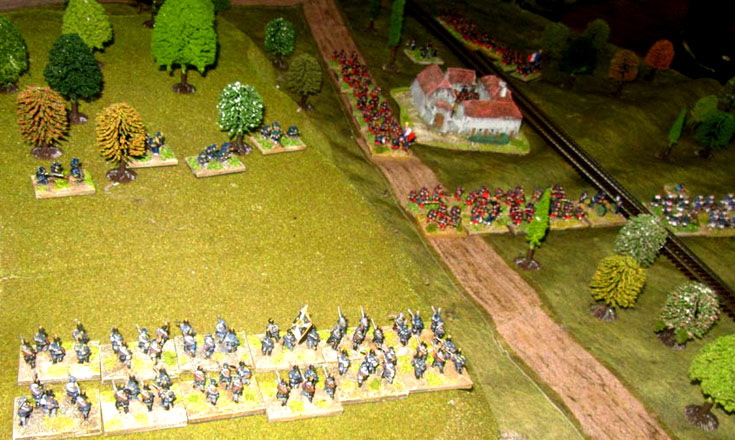
The Battle of Spichern, 1870
13th June 2024, 2 Comments
Bismarck’s Wars, Fire & Fury, 10mm
With Sean away digging holes in the rain-sodden countryside (he’s an sore-kneed archaeologist), Nick and I delved into the Franco-Prussian War, and this game based loosely on the Battle of Spichern, one of those frontier battles in August 1870. Nick’s two divisions of French were charged with holding the line in front of the villages of Forbach and Spichern, and the wooded high ground of the Rotheberg.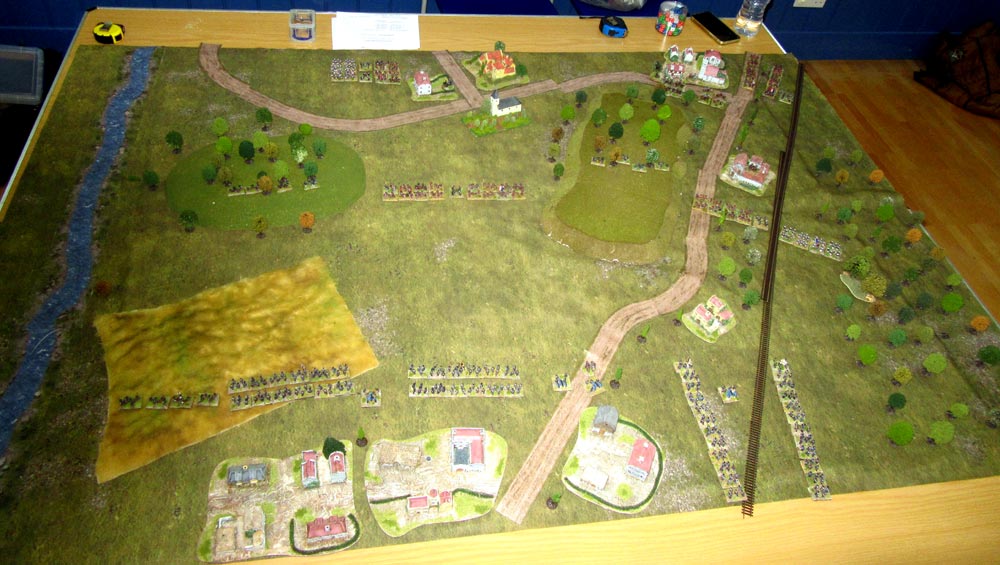 My Prussians – one division of them – were advancing south from Saarbrücken, and historically launched an impetuous attack on the French line. In our game, another brigade of Prussians marched to the sound of the guns and joined in, but in the real thing it was the best part of a Corps, which eventually drove the French back, albeit after suffering heavy casualties. Our assault then, was an altogether more cautious probe of the French line.
My Prussians – one division of them – were advancing south from Saarbrücken, and historically launched an impetuous attack on the French line. In our game, another brigade of Prussians marched to the sound of the guns and joined in, but in the real thing it was the best part of a Corps, which eventually drove the French back, albeit after suffering heavy casualties. Our assault then, was an altogether more cautious probe of the French line. The thing I like about 10mm games using these rules is you sort of get the feel for these divisional and Corps sized battles. It looks right too. In this game, an outnumbered Prussian brigade attacked each of the two French divisions – on the Prussian right one was deployed in front of the ironworks at Stiring Wendel, with the other in a gap between the hills in front of the village of Spichern. We played the game on a 6×4 foot table.
The thing I like about 10mm games using these rules is you sort of get the feel for these divisional and Corps sized battles. It looks right too. In this game, an outnumbered Prussian brigade attacked each of the two French divisions – on the Prussian right one was deployed in front of the ironworks at Stiring Wendel, with the other in a gap between the hills in front of the village of Spichern. We played the game on a 6×4 foot table.  In this the basic unit is the ‘regiment’, the equivalent of a brigade in American Civil War games. The French ones have 8 stands while the Prussians are 12 stands strong. So, in each of the two assaults, the Prussians are outnumbered. However, half of each French division was in reserve, around Spichern and Forbach, along with a small cavalry division and the Corps artillery. So, it would take time for them to get into the fray – and the Prussians knew it.
In this the basic unit is the ‘regiment’, the equivalent of a brigade in American Civil War games. The French ones have 8 stands while the Prussians are 12 stands strong. So, in each of the two assaults, the Prussians are outnumbered. However, half of each French division was in reserve, around Spichern and Forbach, along with a small cavalry division and the Corps artillery. So, it would take time for them to get into the fray – and the Prussians knew it. 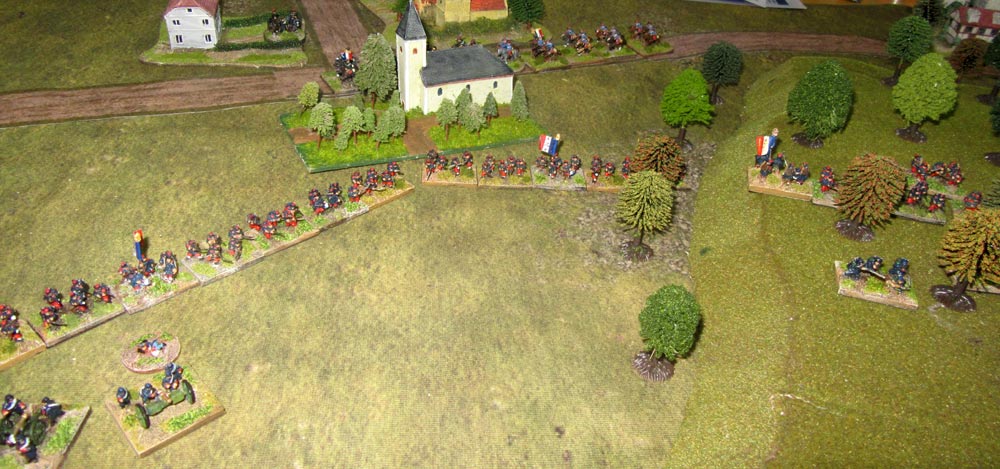 On the left, the Prussians were supported by a jaeger battalion, which faced off French chasseurs ensconced in a small wooded hiill (above), the Erzberg. Nick was quick to bring up his reserves here, and he craftily sent his crack Tirailleur regiment around the side of the hill, between it and the Saar River, to fall on the Prussian flank. Meanwhile his line held its ground, supported by guns and his irritatingly-effective Mitrailleuse machine gun battery!
On the left, the Prussians were supported by a jaeger battalion, which faced off French chasseurs ensconced in a small wooded hiill (above), the Erzberg. Nick was quick to bring up his reserves here, and he craftily sent his crack Tirailleur regiment around the side of the hill, between it and the Saar River, to fall on the Prussian flank. Meanwhile his line held its ground, supported by guns and his irritatingly-effective Mitrailleuse machine gun battery!  On the Prussian right the attack towards the ironworks got into trouble fairly quickly. My regiments were spaced out, with one climbing the Rotheberg and the other hooking to the right, by the railway. The first lot were driven back from the heights by the fire of a battalion of French chasseurs hidden in the woods, while on my right the advance was halted beside Foster farm (above) by heavy French fire. Those French chassepot rifles are very effective!
On the Prussian right the attack towards the ironworks got into trouble fairly quickly. My regiments were spaced out, with one climbing the Rotheberg and the other hooking to the right, by the railway. The first lot were driven back from the heights by the fire of a battalion of French chasseurs hidden in the woods, while on my right the advance was halted beside Foster farm (above) by heavy French fire. Those French chassepot rifles are very effective!  By then though, my reserves appeared – a brigade of two regiments, plus some guns. the brigade advanced along the road leading to Forbach, while the other new arrivals, a small cavalry division headed to the left, to confront those Tirailleurs on the banks of the Saar River. by then though, the Prussian attack against the French division in the valley in front of Spichern was in full swing, supported by two batteries of artillery.
By then though, my reserves appeared – a brigade of two regiments, plus some guns. the brigade advanced along the road leading to Forbach, while the other new arrivals, a small cavalry division headed to the left, to confront those Tirailleurs on the banks of the Saar River. by then though, the Prussian attack against the French division in the valley in front of Spichern was in full swing, supported by two batteries of artillery. 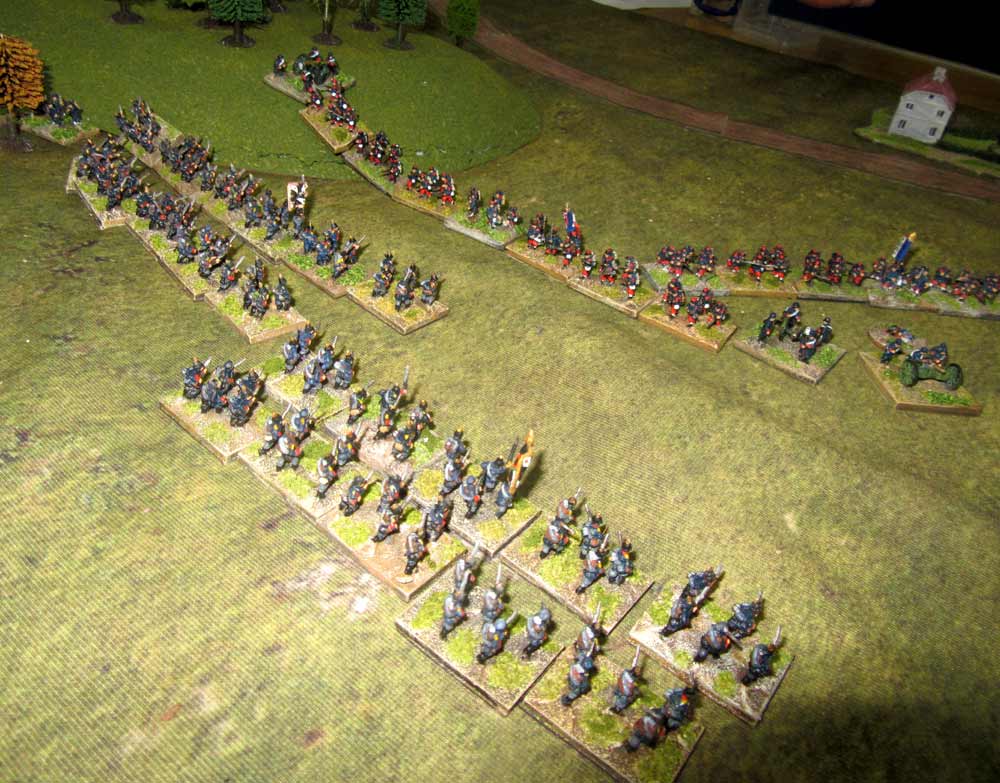 The three big advantages the Prussians have in this period are larger regiments (three battalions strong rather than two), better leaders – they actually get brigade commanders and the French don’t, to help reflect this), and they have better and slightly more plentiful artillery. I made the most of mine, silencing that Mitrailleuse, and disordering some of the French line shortly before the main infantry clash. Still, when it came, it was brutal…
The three big advantages the Prussians have in this period are larger regiments (three battalions strong rather than two), better leaders – they actually get brigade commanders and the French don’t, to help reflect this), and they have better and slightly more plentiful artillery. I made the most of mine, silencing that Mitrailleuse, and disordering some of the French line shortly before the main infantry clash. Still, when it came, it was brutal…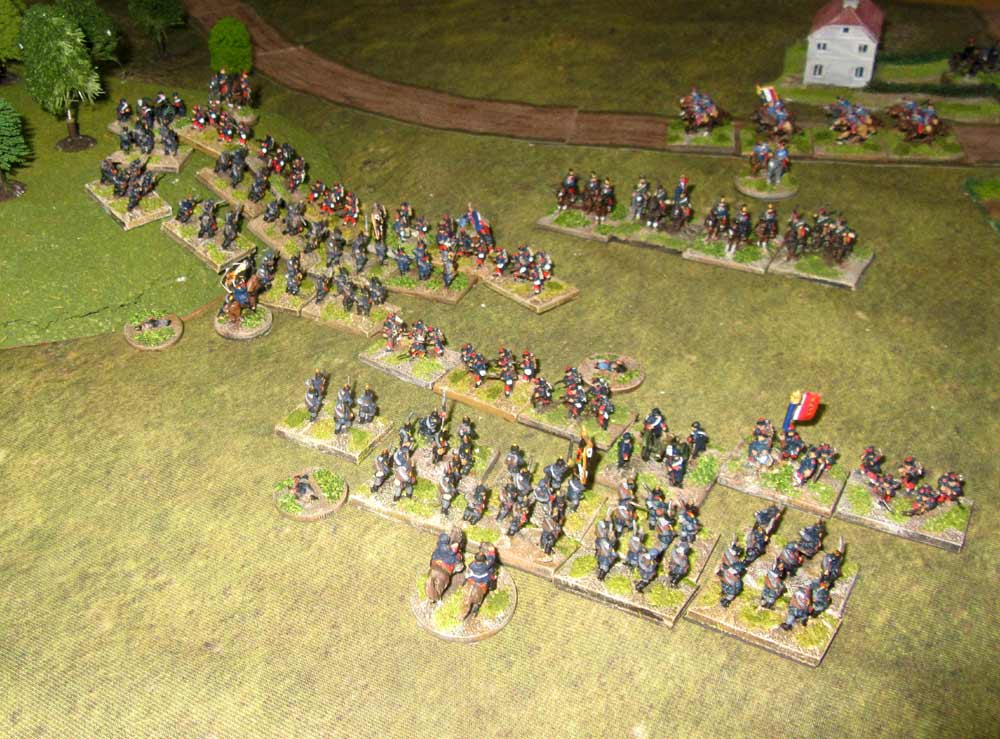 In the melee, the Prussians took some casualties going in, and both regiments were no longer considered ‘fresh’. the french though, took a real spanking. one of their regiments had already been driven back due to artillery fire, so it was a straight fight between two infantry regiments a side. Both French regiments though, either got driven back with heavy causalities, or were swept from the field. Nick though, still had his cavalry.
In the melee, the Prussians took some casualties going in, and both regiments were no longer considered ‘fresh’. the french though, took a real spanking. one of their regiments had already been driven back due to artillery fire, so it was a straight fight between two infantry regiments a side. Both French regiments though, either got driven back with heavy causalities, or were swept from the field. Nick though, still had his cavalry. 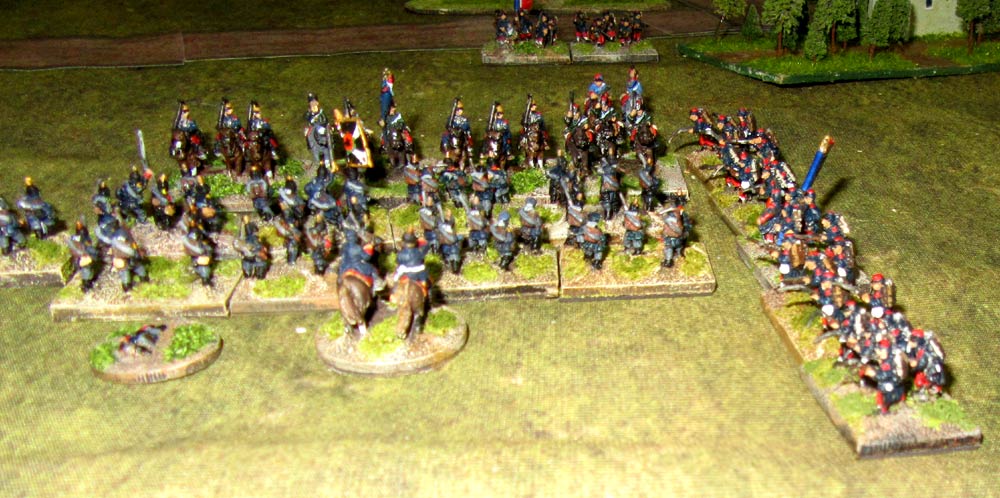 They charged in, supported on one flank by that remaining French infantry regiment, which had been worn down by artillery fire. The Prussians though, held their ground and drove off the cavalry, inflicting heavy casualties as they did so. The French infantry supporting on the flank then got flanking fire of their own, from the guns, which reduced the French regiment to just two stands. Ouch! On that flank then, in front of Spichern, everything went well…
They charged in, supported on one flank by that remaining French infantry regiment, which had been worn down by artillery fire. The Prussians though, held their ground and drove off the cavalry, inflicting heavy casualties as they did so. The French infantry supporting on the flank then got flanking fire of their own, from the guns, which reduced the French regiment to just two stands. Ouch! On that flank then, in front of Spichern, everything went well… However, on the other side of the battlefield it was a different story. My newly-arrived Prussian brigade stormed in, but the leading regiment was driven off, having suffered heavy casualties in the clash. The second regiment held off, forming a rallying point, while on their right the Prussian regiment by the railway tracks was charged by French Zouaves, and driven back too. It was all going to pieces over there, or it would have without the Prussian guns.
However, on the other side of the battlefield it was a different story. My newly-arrived Prussian brigade stormed in, but the leading regiment was driven off, having suffered heavy casualties in the clash. The second regiment held off, forming a rallying point, while on their right the Prussian regiment by the railway tracks was charged by French Zouaves, and driven back too. It was all going to pieces over there, or it would have without the Prussian guns.  Their fire staved off disaster by stopping the Tirailleurs, while the Prussians on the Rotheburg just held onto their toehold on its heights. Still, I wasn’t going to get through to Forbach any time soon – not without reinforcements. So, that’s where we ended the game, with the French holding their left flank, and the Prussians sweeping all before them on their own left flank. We decided to call this very entertaining revolving door of a battle a hard-fought draw!
Their fire staved off disaster by stopping the Tirailleurs, while the Prussians on the Rotheburg just held onto their toehold on its heights. Still, I wasn’t going to get through to Forbach any time soon – not without reinforcements. So, that’s where we ended the game, with the French holding their left flank, and the Prussians sweeping all before them on their own left flank. We decided to call this very entertaining revolving door of a battle a hard-fought draw! 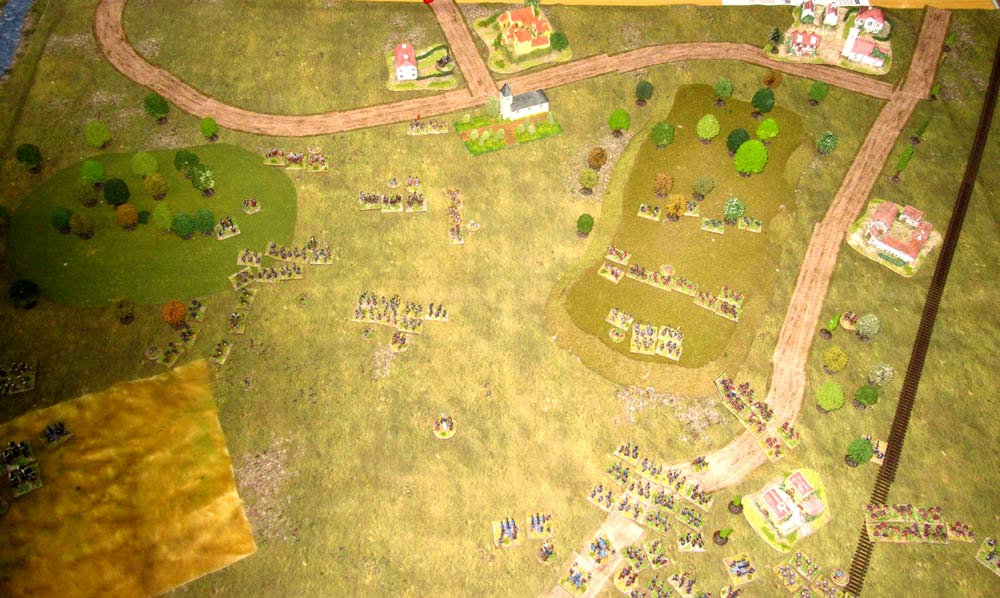



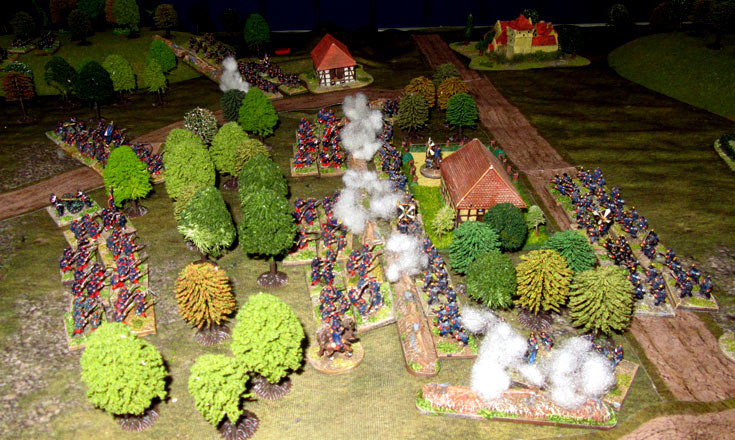

Great looking game and hard fought too. I agree with you the 10mm collection makes the units look like regiments etc. Enjoyable AAR to read.
Thanks Joseph!